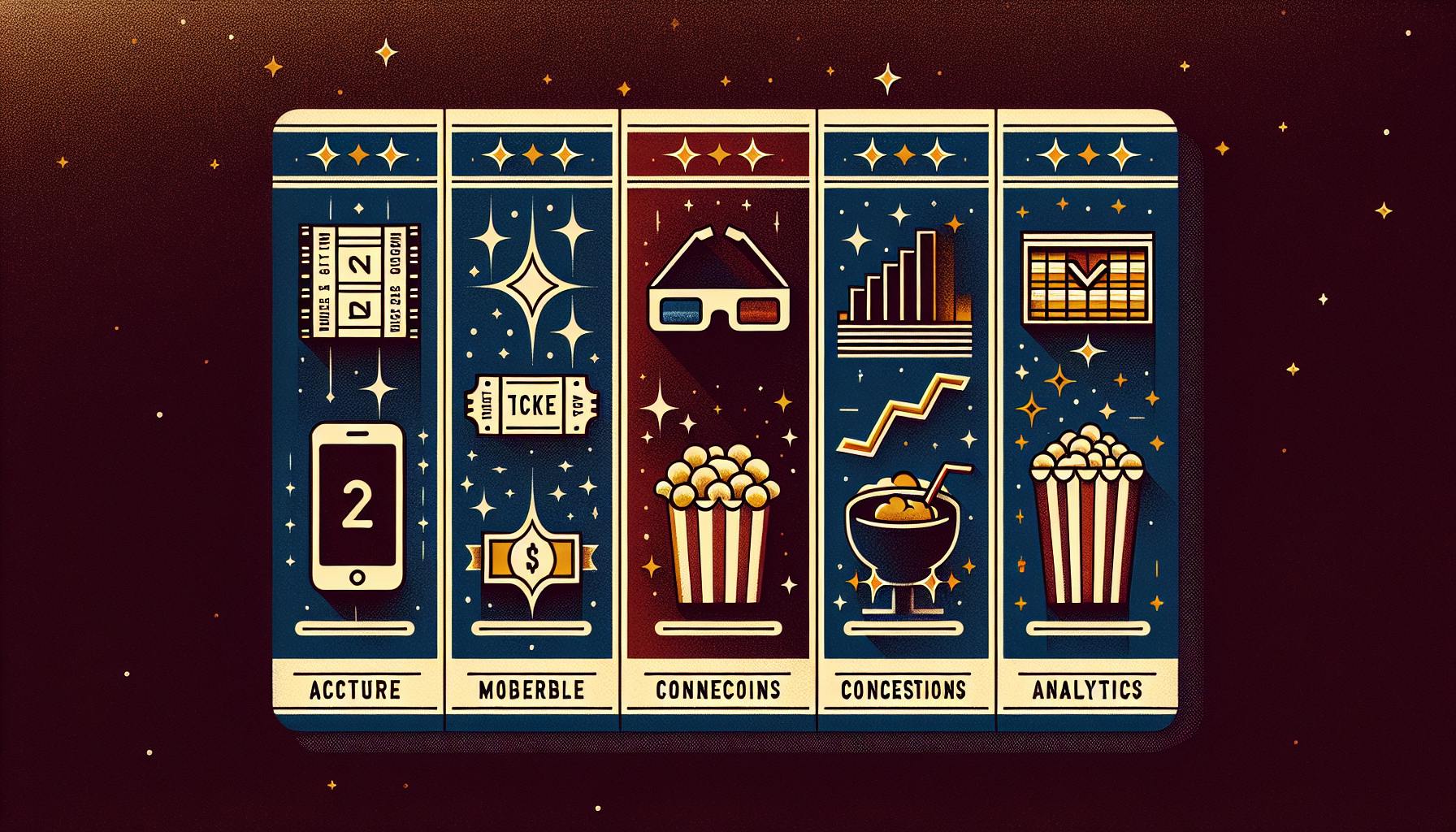Interactive cinema is transforming how you experience movies. Instead of passively watching, you can now actively shape the story by voting on key decisions in real-time. This new format combines the excitement of a theater with the engagement of interactive storytelling, offering multiple outcomes and unique experiences for each screening. Here's what you need to know:
- How It Works: Using a mobile app, audiences vote on character actions or dialogue during pivotal moments. The most popular choice determines the next scene, creating a collaborative viewing experience.
- Why It Matters: It brings people back to theaters by offering something streaming services can't - a shared, participatory event. Early adopters are willing to pay more for this experience, and the replay value encourages repeat visits.
- Technology Involved: AI-powered systems, real-time rendering, and mobile integration make this possible. Upgraded theater infrastructure ensures smooth transitions between storylines.
- Revenue Potential: Higher ticket prices, themed merchandise, group events, and data-driven programming offer new income streams for theaters.
This shift in storytelling is not just a novelty but a way for cinemas to stand out in a competitive entertainment market. By starting with small pilot programs and leveraging platforms like Filmgrail, theaters can gradually adopt this format and lead the charge in this evolving space.
The Gallery: Interactive Cinema Experience - Official Trailer
Technology Behind Real-Time Dialogue Choices
Bringing interactive narratives to life in real-time requires sophisticated technology that can handle audience input and seamlessly adapt the story. Making this work in a theater setting involves systems that not only collect votes but also manage complex narrative branches and validate audience participation.
Core Technologies for Interactive Cinema
AI-powered decision engines are at the heart of this process. These engines analyze voting patterns, predict likely outcomes, and manage transitions between different storylines. They can even assign weight to votes based on patterns observed earlier, ensuring smooth decision-making.
Real-time rendering platforms make it possible to switch between story paths without breaking immersion. These platforms dynamically assemble pre-rendered scene segments based on audience choices, enabling seamless transitions.
Mobile app integration serves as the main way for audiences to participate. These apps sync with the theater’s projection system, displaying voting options at just the right moments, ensuring a smooth and interactive experience.
Biometric feedback systems take things a step further by measuring engagement through heart rates or facial expressions. This data can be used to adjust the pacing of the story, making the experience even more engaging for viewers.
Infrastructure Requirements for Theaters
To support interactive cinema, theaters need upgraded systems, including high-speed internet, robust bandwidth, and projectors capable of rapid content switching.
Local processing systems are also critical. These systems can cache different story branches and handle vote aggregation on-site, reducing reliance on external networks. This ensures that even if there’s an internet hiccup, the show can go on without interruption.
Audience engagement platforms like Filmgrail provide the necessary software to manage these screenings. These platforms handle everything from onboarding viewers before the show to collecting votes during the screening and analyzing audience preferences afterward. They integrate seamlessly with existing cinema management systems.
Upgraded sound systems are equally important. Since different story paths may feature unique audio cues or soundtracks, theaters need audio solutions that can transition smoothly between multiple tracks without any lag.
Creating a Smooth Experience
To ensure a seamless experience, theaters rely on pre-rendering strategies and buffer management. This allows transitions between story branches to happen without delays, no matter what the audience chooses.
Intelligent input aggregation goes beyond just counting votes. These systems might use algorithms that factor in response times and past engagement to create a balanced and inclusive decision-making process.
Fallback mechanisms are essential for maintaining narrative flow. If technical issues arise, default story paths can automatically activate, ensuring the audience isn’t left in suspense due to a glitch.
Synchronization protocols are key to keeping everything in sync - screens, sound systems, and mobile devices. These protocols ensure voting prompts and scene transitions happen at the same time for everyone, maintaining immersion and continuity.
With these technologies working together, interactive cinema can deliver a captivating and cohesive experience, allowing audiences to fully engage in stories that evolve based on their choices.
How to Implement Real-Time Dialogue Choices in Cinemas
Bringing interactive cinema to life takes thoughtful planning and a step-by-step approach. Theater operators must juggle technical upgrades, operational adjustments, and audience expectations to ensure a smooth and enjoyable experience right from the start.
Steps to Adoption
Start small with a pilot program in one or two auditoriums. This allows you to test the systems, collect valuable audience feedback, and address any technical glitches before committing to a full-scale rollout. Use this phase to gather data on participation rates, technical performance, and audience satisfaction. These insights will guide future programming decisions and ensure your setup can handle the demands of live audience interaction.
Once the pilot program proves successful, gradually expand to more screens. At this stage, integrating the interactive screenings with your existing ticketing and scheduling systems is crucial. Box office staff should be well-prepared to explain the unique aspects of these screenings, and your scheduling system must accommodate the specific timing needs of interactive films.
Incorporate these screenings into your regular programming by training staff, creating standard operating procedures, and crafting marketing campaigns that showcase your theater’s innovative offerings. These steps help build a strong foundation for interactive cinema.
Using Cinema Engagement Platforms
After the pilot phase, digital platforms are key to managing the complexities of interactive experiences. Platforms like Filmgrail provide the digital infrastructure needed for seamless implementation. They handle tasks like collecting audience votes, managing participation, and integrating with your existing cinema management systems.
Filmgrail offers custom mobile apps that serve as the main tool for audience interaction. These apps can be branded specifically for your theater and include features like auto-playing trailers and video stories to build excitement before the screening. Push notifications can alert users when interactive screenings are available, targeting those who have shown interest in similar content.
The platform’s analytics tools are invaluable for refining your offerings. You can track audience preferences, pinpoint peak engagement moments, and analyze participation trends by demographics. This data helps you select interactive content that aligns with your audience’s tastes.
To foster a sense of community, platforms often include local engagement features like reviews and ratings from attendees in your area. This social aspect encourages repeat visits and word-of-mouth promotion, both of which are vital for sustaining interactive cinema programs. Additionally, the platform’s cinema CMS capabilities allow you to manage interactive content, schedule special events, and coordinate marketing campaigns that emphasize the unique, audience-driven storytelling experience.
Staff Training and Operations
Once the digital systems are in place, thorough staff training is essential for delivering seamless interactive screenings. Staff need to be well-versed in both technical troubleshooting and operational procedures.
Technical training should focus on resolving common issues like connectivity problems or difficulties with the voting interface. Staff should also know how to assist audience members who may struggle with connecting to the theater’s Wi-Fi or navigating the app.
Managing the crowd takes on new challenges with interactive screenings. Team members should be ready to explain the interactive features during pre-show announcements and assist anyone unfamiliar with the technology. Stationing staff throughout the auditorium during the first few screenings can help quickly address participation issues.
Having contingency plans is critical. Staff should know how to switch to a default story path in case of technical problems and communicate these changes to the audience in a way that keeps them engaged.
Consistency is key, so regular rehearsals and clear operational checklists are a must. This ensures every audience member gets the same high-quality experience, no matter who is working the screening.
Investing in proper implementation pays dividends through increased audience engagement, premium ticket pricing for these unique experiences, and a competitive edge in offering something that sets your theater apart from the rest.
sbb-itb-b1b0647
Marketing and Making Money from Interactive Screenings
Interactive cinema opens up exciting ways to generate revenue by focusing on the right audience, clearly showcasing its unique appeal, and diversifying income streams.
Finding the Right Audience
To succeed, marketing efforts need to connect with audiences who are most likely to embrace interactive storytelling.
- Gaming enthusiasts: With their familiarity with apps and choice-based experiences, gamers are a natural fit for interactive cinema.
- Millennials and Gen Z: Having grown up with interactive media, these groups are quick to engage and often share their experiences, creating organic buzz.
- Date night couples: Offering a fun, memorable outing, interactive screenings can appeal to couples looking for something new, especially during quieter weekday evenings.
- Film lovers and cinephiles: Those who frequent film festivals or enjoy experimental storytelling are often eager to explore interactive formats.
- Corporate groups and private events: Companies and party planners can use interactive screenings for team-building or celebrations, turning movies into collaborative experiences.
Explaining the Value
Interactive screenings stand out from traditional movies, but their appeal needs to be clearly communicated. People need to understand how the interactive elements work and why they’re worth trying.
Social media is a powerful tool here. Short clips showing audiences using their phones to influence the story can grab attention, while behind-the-scenes content can explain the technology without spoiling the plot. This builds excitement and sets expectations, emphasizing the personalized control audiences have over the narrative.
Filmgrail’s push notifications and auto-playing trailers are great for grabbing attention and building anticipation. Local partnerships with gaming or tech groups can also help spread the word. In addition, well-trained staff and box office teams who can confidently explain the concept play a big role in converting curious customers into ticket buyers. Loyalty programs - offering perks like early access to new interactive films or bonus points - can encourage repeat visits and create a dedicated fan base.
Revenue Opportunities
Interactive screenings justify higher ticket prices due to their unique, participatory nature. Plus, the ability to explore different story outcomes encourages repeat visits, boosting long-term revenue.
Additional opportunities include:
- Merchandise and partnerships: Exclusive items or collaborations with filmmakers can extend the experience beyond the theater.
- Group packages and private events: Special occasions like corporate outings or birthday parties benefit from the collaborative decision-making aspect of interactive cinema. Bundled concession deals can make these events even more appealing.
- Concession tie-ins: Themed snacks or drinks tied to the interactive experience can increase per-customer spending.
- Data-driven strategies: Tools like Filmgrail’s cinema analytics help track audience preferences and participation trends, allowing theaters to fine-tune pricing and scheduling for maximum impact.
- Sponsorships: Local businesses can sponsor specific parts of the experience, such as voting segments or pre-show activities, creating an additional revenue stream.
- Subscriptions and season passes: Offering packages for multiple screenings can provide predictable income while rewarding loyal customers.
These strategies not only maximize current revenue but also pave the way for future advancements in the interactive cinema space.
Future of Interactive Cinema
Interactive cinema is reshaping how we experience movies. By introducing real-time dialogue choices, it creates a more engaging, participatory environment for viewers. This shift offers something entirely different from traditional screenings, paving the way for a new era of storytelling. Below, we’ll explore the latest trends and what lies ahead for this evolving medium.
New Trends in Interactive Storytelling
Artificial intelligence is pushing interactive cinema beyond simple “choose-your-own-adventure” formats. AI can now craft more personalized experiences by adapting dialogue options based on how audiences engage with the story. On top of that, biometric feedback - like tracking heart rates or facial expressions - can further customize narratives, making the experience feel even more immersive.
Theater technology is also advancing to support these innovations. With the rollout of 5G, latency issues are minimized, enabling features like augmented reality overlays that add layers of interaction. Some theaters are even experimenting with multi-sensory elements, such as scent dispensers or tactile feedback systems, to create an atmosphere that stimulates multiple senses during the film.
Growth and Scalability
As these technologies mature, the question isn’t whether interactive cinema will grow, but how quickly it can move from niche experiences to mainstream entertainment. Early trends suggest a steady expansion, with premium interactive screenings potentially commanding higher ticket prices for audiences seeking something beyond the ordinary.
However, integrating these interactive elements into traditional filmmaking processes isn’t without its challenges. Production tools and workflows must evolve, and filmmakers need room to experiment creatively. Audience reception will likely vary depending on demographics and location, with urban areas often being more open to adopting cutting-edge cinema experiences.
To balance innovation with practicality, many theaters are adopting a hybrid model. This approach designates specific screens or showtimes for interactive content while leaving traditional screenings untouched. Theaters with modern infrastructure are better positioned to embrace these changes quickly, making it easier to test and implement new formats.
Getting Ready for What's Next
For theaters to stay ahead, upgrading network capabilities is a must. Enhanced Wi-Fi and 5G readiness are critical not only for interactive screenings but also for other digital initiatives. Training staff and educating customers on how these experiences work will also be key to a smooth transition.
Partnerships with technology providers can help streamline this shift. For example, companies like Filmgrail are already collaborating with theaters to integrate interactive features into existing cinema management systems. Pilot programs offer another smart way to test interactive content without requiring massive upfront investments. By analyzing data from mobile apps and loyalty programs, theaters can better understand audience preferences and refine their offerings.
Collaborating with independent filmmakers and film schools could also give theaters access to exclusive, experimental content. These partnerships can help set a venue apart, offering unique experiences that draw in curious moviegoers and build excitement around interactive cinema.
Conclusion
The rise of real-time dialogue choices is reshaping the way we experience movies, turning passive viewing into an engaging, interactive journey where every decision counts. This shift isn't just a passing trend - it’s a step toward redefining storytelling in cinema. For theater operators, it’s not only about keeping up with the times but also about leading the charge in this evolving landscape.
To make this vision a reality, theaters will need strong network infrastructure, like 5G and upgraded Wi-Fi, along with knowledgeable staff to guide audiences through these new interactive formats.
Companies such as Filmgrail are already paving the way by offering tools like mobile apps, content management systems, and marketing resources that enhance the digital side of interactive cinema. Their focus on engaging moviegoers through features like auto-playing trailers, video stories, and local audience reviews lays the groundwork for this innovation to succeed.
Interactive screenings don’t just offer a fresh experience - they also open the door to premium pricing and new marketing opportunities. Early adopters of this technology will stand out in a crowded market, attracting audiences eager for something beyond the traditional movie night.
The path forward is clear: start small with pilot programs, invest in the right technology, and partner with experts in the field. Theaters that act now will be ready to lead as interactive cinema transitions from a novel idea to a mainstream form of entertainment. The future of cinema is here - embrace it and set the stage for tomorrow’s moviegoers.
FAQs
How do theaters seamlessly switch between storylines during interactive movie screenings?
Theaters rely on cutting-edge technology to deliver smooth transitions during interactive screenings. Tools like synchronized projections, dynamic lighting, and carefully timed scene changes work together to create an immersive experience where shifts between story arcs feel effortless.
On top of that, advanced narrative management systems and branching algorithms play a crucial role in coordinating multiple plotlines. These systems ensure the story flows naturally, keeping the audience engaged without any jarring interruptions.
What challenges might theaters face with real-time dialogue choices, and how can they address them?
Theaters often face hurdles that can disrupt the storytelling experience, such as unclear dialogue caused by overpowering sound effects or poor audio balancing. These technical issues can pull audiences out of the moment, making it harder for them to stay immersed in the story.
One way to tackle this is by investing in advanced audio calibration. This ensures dialogue remains crisp and clear, while sound effects are kept at a balanced level. Another solution is leveraging AI-driven adjustments that fine-tune sound and visuals in real time. These tools work together to create a seamless and engaging experience, allowing moviegoers to stay fully immersed in the narrative while enjoying cutting-edge cinema technology.
How does interactive cinema make the movie-going experience more engaging than traditional screenings?
Interactive cinema is changing how we experience movies by putting the audience in the driver’s seat. Instead of just sitting back and watching, viewers get to make real-time decisions that directly impact the storyline. This hands-on approach doesn’t just make the plot more engaging - it creates a stronger emotional bond and gives audiences a sense of ownership over how the story unfolds.
What makes this format so exciting is its unpredictability. Every screening can feel like a brand-new experience, almost like live theater, where the audience's input shapes the outcome. By inviting viewers to actively participate, interactive cinema brings a fresh and dynamic twist to storytelling on the big screen.


